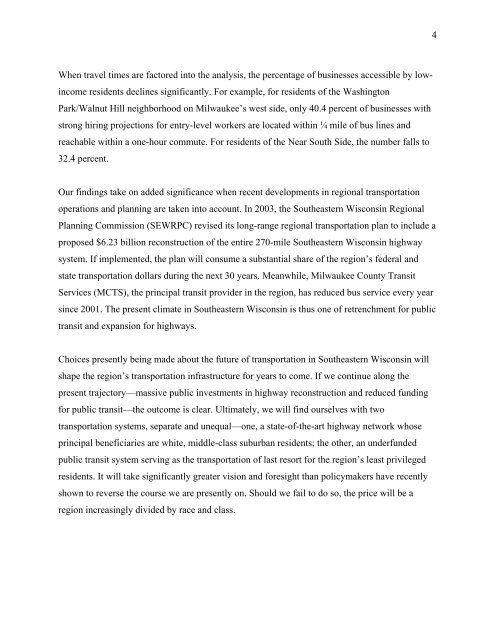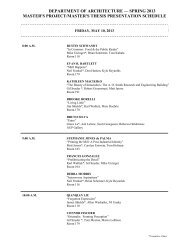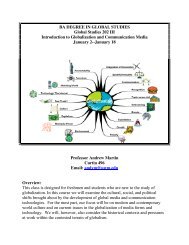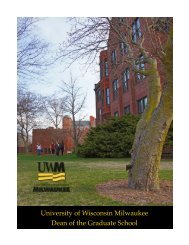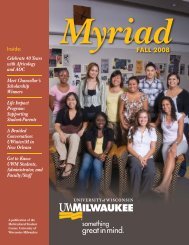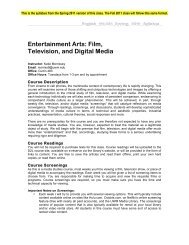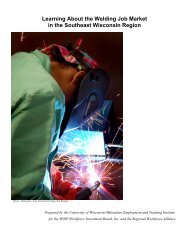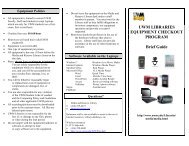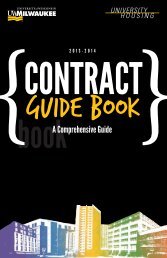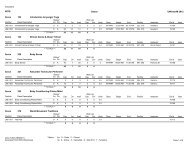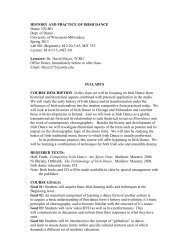Transportation Equity and Access to Jobs in ... - UW-Milwaukee
Transportation Equity and Access to Jobs in ... - UW-Milwaukee
Transportation Equity and Access to Jobs in ... - UW-Milwaukee
Create successful ePaper yourself
Turn your PDF publications into a flip-book with our unique Google optimized e-Paper software.
4When travel times are fac<strong>to</strong>red <strong>in</strong><strong>to</strong> the analysis, the percentage of bus<strong>in</strong>esses accessible by low<strong>in</strong>comeresidents decl<strong>in</strong>es significantly. For example, for residents of the Wash<strong>in</strong>g<strong>to</strong>nPark/Walnut Hill neighborhood on <strong>Milwaukee</strong>’s west side, only 40.4 percent of bus<strong>in</strong>esses withstrong hir<strong>in</strong>g projections for entry-level workers are located with<strong>in</strong> ¼ mile of bus l<strong>in</strong>es <strong>and</strong>reachable with<strong>in</strong> a one-hour commute. For residents of the Near South Side, the number falls <strong>to</strong>32.4 percent.Our f<strong>in</strong>d<strong>in</strong>gs take on added significance when recent developments <strong>in</strong> regional transportationoperations <strong>and</strong> plann<strong>in</strong>g are taken <strong>in</strong><strong>to</strong> account. In 2003, the Southeastern Wiscons<strong>in</strong> RegionalPlann<strong>in</strong>g Commission (SEWRPC) revised its long-range regional transportation plan <strong>to</strong> <strong>in</strong>clude aproposed $6.23 billion reconstruction of the entire 270-mile Southeastern Wiscons<strong>in</strong> highwaysystem. If implemented, the plan will consume a substantial share of the region’s federal <strong>and</strong>state transportation dollars dur<strong>in</strong>g the next 30 years. Meanwhile, <strong>Milwaukee</strong> County TransitServices (MCTS), the pr<strong>in</strong>cipal transit provider <strong>in</strong> the region, has reduced bus service every years<strong>in</strong>ce 2001. The present climate <strong>in</strong> Southeastern Wiscons<strong>in</strong> is thus one of retrenchment for publictransit <strong>and</strong> expansion for highways.Choices presently be<strong>in</strong>g made about the future of transportation <strong>in</strong> Southeastern Wiscons<strong>in</strong> willshape the region’s transportation <strong>in</strong>frastructure for years <strong>to</strong> come. If we cont<strong>in</strong>ue along thepresent trajec<strong>to</strong>ry—massive public <strong>in</strong>vestments <strong>in</strong> highway reconstruction <strong>and</strong> reduced fund<strong>in</strong>gfor public transit—the outcome is clear. Ultimately, we will f<strong>in</strong>d ourselves with twotransportation systems, separate <strong>and</strong> unequal—one, a state-of-the-art highway network whosepr<strong>in</strong>cipal beneficiaries are white, middle-class suburban residents; the other, an underfundedpublic transit system serv<strong>in</strong>g as the transportation of last resort for the region’s least privilegedresidents. It will take significantly greater vision <strong>and</strong> foresight than policymakers have recentlyshown <strong>to</strong> reverse the course we are presently on. Should we fail <strong>to</strong> do so, the price will be aregion <strong>in</strong>creas<strong>in</strong>gly divided by race <strong>and</strong> class.


